With 4 main regions, consisting of the Rocky Mountains, the Great Plains, the Basin and Range region, and the Colorado Plateau, there is a little something for many different birds in the Enchantment state. Today we are going to explore the birding scene in the Great Southwest. We’ll let you know some of the beautiful birds that you can see here, as well as what they like to eat, and where they like to hide. We’ll top that off with a little feeder advice and give you a list of hotspots as well if you happen to be visiting New Mexico or if you are simply a local looking to see a little more of this beautiful state. Let’s talk about the popular backyard birds of New Mexico!
3 Categories – 542 Birds
When they call it the ‘Land of Enchantment’ they aren’t kidding. New Mexico is host to a whopping 542 species of birds! That’s quite a lot of species to spot and while we obviously can’t give you a list of every one, we CAN give you a sampling of birds to look for to get started. We’ll divide them up seasonally like this:
- Year-round Resident birds
- Birds of Spring, Summer, and Early Fall
- Fall and Winter Birds
This way you will know when to look for these winged wonders and with the information that we’ll provide you will also have the scoop of some great feeder options to attract them to your backyard. Let’s get started with the year-round resident birds!
New Mexico’s Year-round Resident birds
The birds that you’ll see below fell in love with the Southwest a long time ago and don’t have any plans for going anywhere else. These birds stay put, whatever the season, and may be seen at any time of the year if you know where to look for them (or what to leave out in your feeder!). See if you can spot one of these New Mexico Year-round resident birds:
- Common Raven
- Canyon Wren
- Dark-eyed Junco
- White-winged Dove
- American Robin
Common Raven – Corvus corax
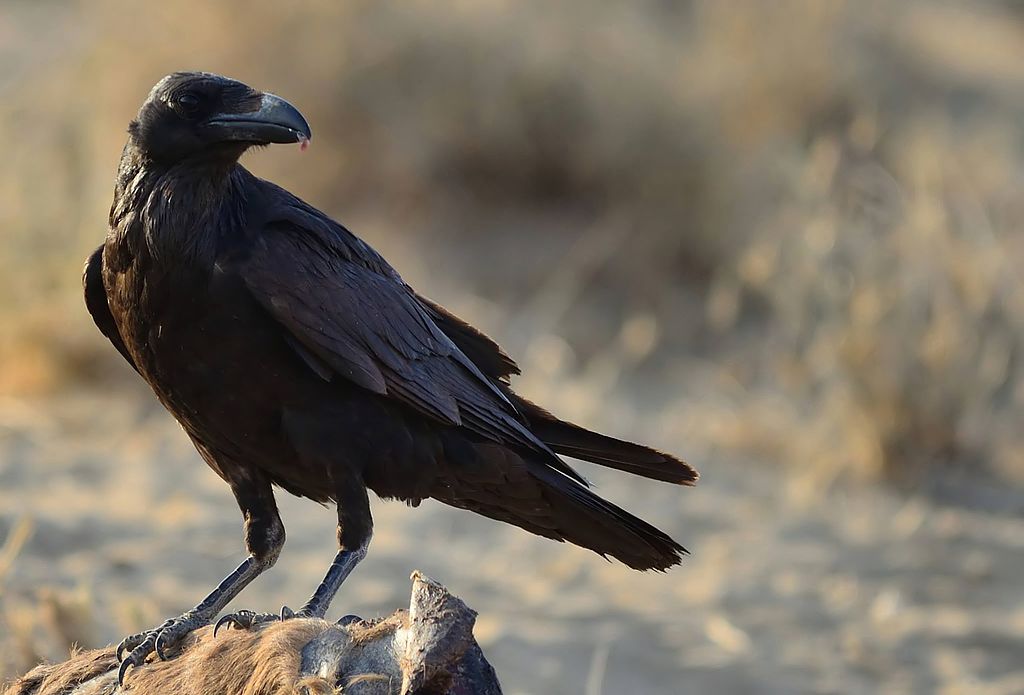
Coloration and Markings: Black, black, and more black… The Common Raven is black all over, even at the bill and the legs, and has long wings to go with a long tail and facially, a very stout black bill with a noticeable curve on the upper bill.
Size: These birds measure in at 22.1 – 27.2 inches in length and have wingspans of 45.7 to 46.5 inches.
Habitat: When in the woods, open or deep areas are both fine for the Common Crow. They do have a preference for Evergreen or deciduous woods but will ‘make do’ if this is not possible. They are also quite comfortable in the city, where you will catch these inquisitive birds watching you, fighting other Ravens over a snack (they are less social than Crows), and getting into trash cans and dumpsters if they suspect that they will find delicious snacks there.
Diet: Ravens will eat just about anything that you put out. In the wild they eat rodents, eggs, carrion, nuts, and berries, and even hang around mall parking lots sometimes looking for dropped human food. Get creative with the feeder but if you just want something basic you can just leave out a combo of suet and peanuts and they’ll be quite happy with this. You can also put up a Raven silhouette made out of wood or tin and painted black. This old Southwest trick can attract Ravens, looking to investigate what those ‘other Ravens’ are so interested in inside your backyard.
Canyon Wren – Catherpes mexicanus

Coloration and Markings: Canyon Wrens have short wings and backs which are rust-red, barred with dark brown. They have long tails that are much brighter, being a fox-red color with almost black barring. The breast and underbelly of this bird are rust-red as well and from the top of the breast to underneath the bill this bird is white. This white coloration extends horizontally almost to the back of the head, with the remaining uppwer portion of the face being the banded-patterns, with heavier brown then rust. These birds have long, curved, yellow and black bills.
Size: These birds measure in at 4.5 – 6.1 inches in length and have wingspans of 7.1 to 7.9 inches.
Habitat: As the name suggests, these birds are most often going to be found between 1000 and 6000 foot elevations, inhabiting slopes and canyons. They can be seen in some parks on occasion and they range out to forage sometimes, so keep your eyes peeled and you might just spot a Canyon Wren!
Diet: While primarily insectivorous, Canyon Wrens can sometimes be tempted with small pieces of suet or crushed peanuts.
Dark-eyed Junco – Junco hyemalis

Coloration and Markings: Dark-eyed Juncos can have a lot of regional variants, but in the United States you will most commonly see the variety which is slate gray on the upper 2/3 of it’s body and white below. Look for a bird that is dark brown or gray on it’s back, as well as it’s medium-length wings, and on the top of it’s long tail. The undersides of the tail will be white and while the rump is white, at the white underbelly you will see a flanking of dark or gray, as if the bird were wearing a vest, and this flanking increases in width as it approaches the breast, relegating the white color to the center. Facially, this bird is completely dark brown or gray with the exception of a stout, medium-length, conical pink bill.
Size: These birds measure in at 5.5 – 6.3 inches from tip to tail with wingspans of 7.1 to 9.8 inches.
Habitat: Dark-eyed Juncos prefer confierous woods but will settle for mixed coniferous, but don’t look for them in the trees. You re much more likely to spot them hopping on the ground as they forage for seeds and other snacks. They are not shy about ranging out to visit parks or backyards, so be sure to leave a little something out for them and you might just make a new friend.
Diet: Black Oil Sunflower seeds and suet can attract this bird, but you will want to use a ground feeder and to be sure and spread some seeds on the ground around the feeder just to help get their attentions.
White-winged Dove – Zenaida asiatica

Coloration and Markings: White-winged Doves will typically have light brown or gray backs, with long, light brown wings that typically become black close to the tips and will show a thick white band on the edges at the bottom of the wing when the bird is at rest. They have medium-length tails which are white tipped, just under a thin black line, with the rest of the upper portion of the tail being a mix of gray and foxy red-browns. This bird has white rump but the underbelly and breast will be gray to tan in color, sometimes a little of both with the underbelly starting gray and turning tan as the coloration moves up. Facially, these birds have a distinct black streak across the cheek as well as some blue skin that you will see around this Dove’s red eyes. This bird has a medium length, slightly curved black bill.
Size: These Doves measure in at approximately 11 inches from head to tail and have wingspans of 18.9 to 22.8 inches.
Habitat: Commonly seen roosting on Cacti, these birds love the desert, but they will happily visit parks and backyards (especially backyards with birdbaths!). They are also quite at home in the city, though you will see them there with greater frequency once mating season is over.
Diet: These birds eat a lot of Saguaro cactus fruit in the wild, but you can attract their attention to your feeder with a simple fare of cracked corn, Black Oil Sunflower seeds, wheat, or fresh, chopped fruits of your choice. White-winged Doves are easy to please!
American Robin – Turdus migratorius
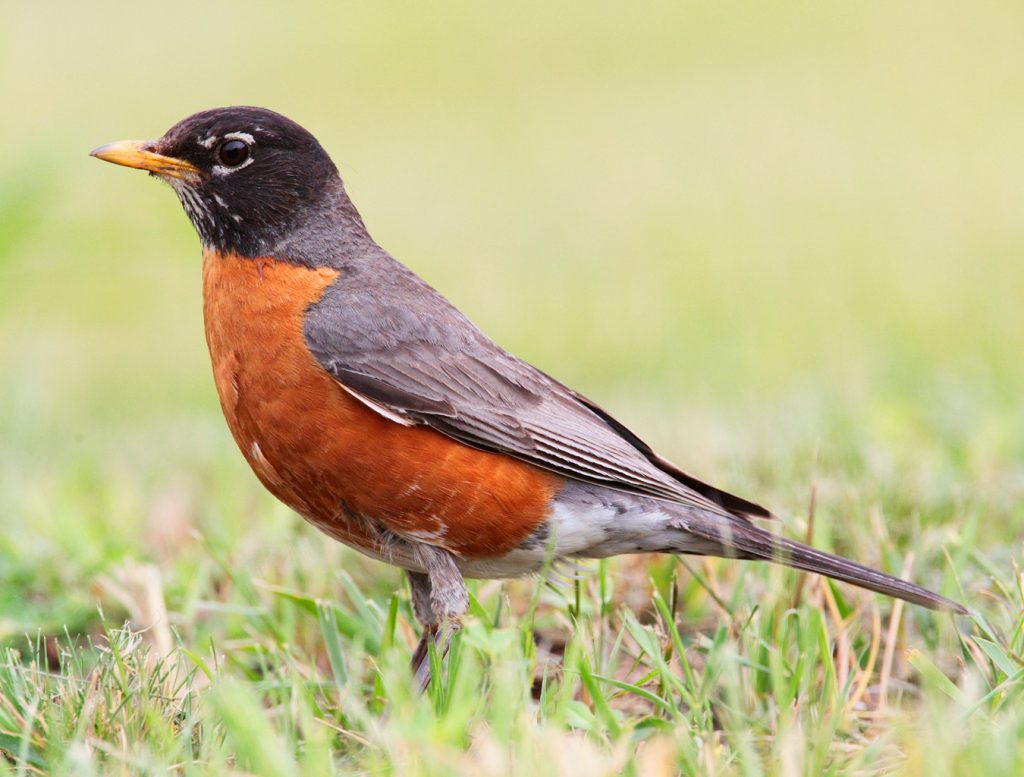
Coloration and Markings: American Robins have gray or dark brown backs with long wings of the same color, as well as long tails which will be dark rown or gray on top, with minute white edging and some white below which is coming from the rump. The breast and underbelly of this bird are orange to red-orange and facially, this bird has a black face and a white eyering which is ‘broken up’ into quarters rather than whole. This bird has a stout, medium-length, slightly curved yellow bill. Females will look much the same, however they will have muted colors which run together more in comparison to the color-contrast of the male’s plumage.
Size: These birds measure in at 7.9 – 11 inches and have a wingspans of approximately 12.2 to 15.8 inches.
Habitat: While they favor deciduous birds, American Robins range about to all sorts of places. You can see them in fields, pastures, hopping around in the snow, or even at the local golf course. They are comfortable around inhabited areas and will happily visit a well-stocked feeder if you have left out something which they like.
Diet: These birds will eat a lot of different types of foods, but you can keep things simple by luring them in with a little suet, Black Oil Sunflower seeds, or a little strawberry or grape jelly.
New Mexico’s Birds of Spring, Summer, and Early Fall
When the Rosemary and Forsythia start to bloom after a cold, bleak winter, then spring has arrived! A number of birds will be arriving as well, filling the air with frolic and song, and probably getting into your gardens when they are just starting to rev back up for action (better stock up those feeders!). See if you can spot one of the following birds of spring, summer, and early fall:
- Barn Swallow
- Black-chinned Hummingbird
- Western Kingbird
- Townsend’s Solitaire
- Lark Bunting
Barn Swallow – Hirundo rustica
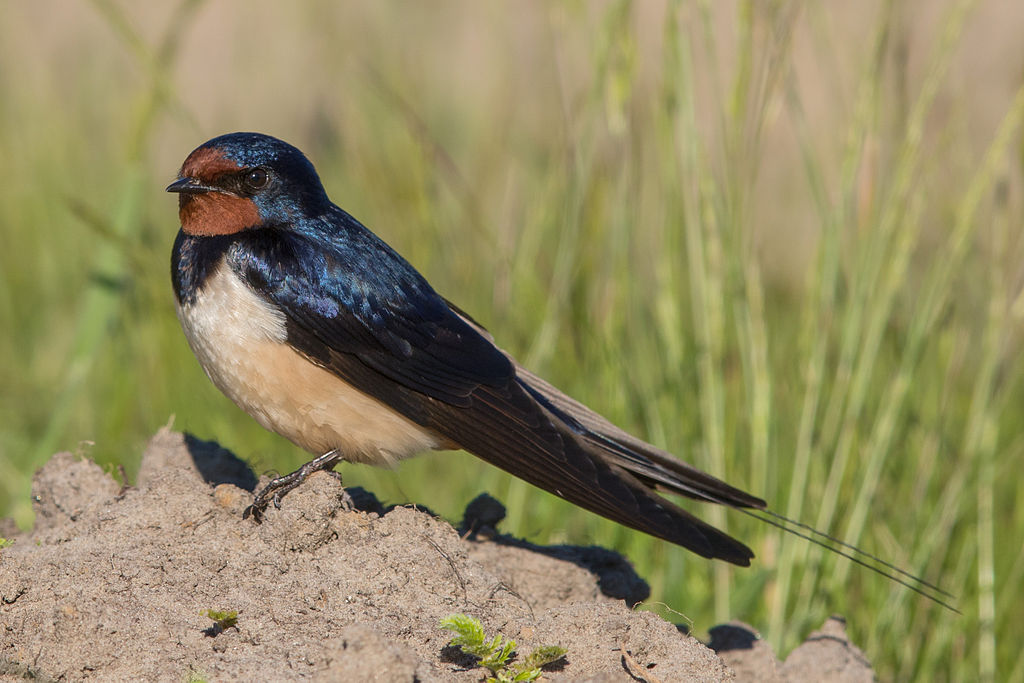
Coloration and Markings: Barn Swallows are often depicted in commercial art as tiny cartoon ‘superhero birds’. They have deep blue backs, as well as long, deep blue wings and medium length blue tails which are forked. The breast and underbelly of this bird are orange, with some tiny tufts of white just under the wings and around the shoulder-top, close to the cheek when the bird is at rest. The blue from the wings does a neat trick, with the coloration carrying over the shoulders and down across the breast on both sides. This looks like tie-fasteners for holding a cape and the effect is both lovely and a little amusing. Between the ‘fasteners’ the orange tends to become richer, often a little redder as well, and this carries on into the face where it stops just high enough to frame the cheeks though it does pass through the bill, triangulating to stop just above it. The remainder of the birds face is deep blue, with the exception of a diamond-shaped mask and the birds small, sharp black black, which shows a very slight curve on the upper bill area. Females will have a slightly muted color and on both genders there are some white spots underneath the wings that you might see when the bird is in flight but they are very hard to spot.
Size: These birds measure 5,9 – 7.5 inches from tip to tail and have wingspans of 11.4 to 12.6 inches in width.
Habitat: These birds love open areas, especially those close to water. Look for them at the forest’s edge or close to marshes, ponds, or even the coast. They are also common around farms and cities, taking advantage of sheds and bridges in the area where they will sometimes build a nest.
Diet: While these birds will sometimes eat a little suet, more often than not they will leave your feeder alone. You can tempt them a little with crushed eggshells which these little birds will devour. The reason has not been confirmed although it is believed that the eggshells aid the bird in digestion.
Black-chinned Hummingbird – Archilochus alexandri

Coloration and Markings: Male Black-chinned Hummingbirds will have black and dark green backs, long wings, and short tails. Their underbelly and breast will be white and gray, with a a flanking of metallic, emerald green which grows wider as the color moves up the breast. At the base of the male’s throat is a thin, purple line, and from here into the face this bird will be black, with dark green sometimes seen, and a long, thin, lightly-curved black bill. Females will display a lighter throat and will have distinctive white tips on their tails.
Size: These diminutive little angels measure in at a mere 3.5 inches from tip to tail and have wingspans of approximately 4.3 inches in width.
Habitat: Black-chinned Hummingbirds are quite versatile when it comes to where you might find them. You can see them in the woods when hiking in the mountains, spot them in the lowland desert, or simply hunting for snacks in your town. These birds are quite urbanized and happy to visit your Hummingbird feeder if you’ve got one!
Diet: No need for suet or seed with this bird, just put out the sugar water which you usually use for the Hummingbird feeder and these little guys will be pleased as punch.
Western Kingbird – Tyrannus verticalis

Coloration and Markings: Western Kingbirds have gray backs, sometimes with a little olive green mixed in, and the upper portion of the long, brown wings will match the back’s coloration in a neat, oval shape. They have medium-length black tails with white outer feathers and squared tips, and the breast and underbelly of this bird are bright yellow, which becomes white as you reach the upper portions of the breast and the throat. Facially, this bird is gray to blue-gray and a black eyestripe is often present passing through the lower half of the eye. This bird has a long, straight black bill.
Size: These birds measure in at 7.9 – 9.4 inches in length and have wingspans of 15 to 16.1 inches.
Habitat: Western Kingbirds love open areas, spending much of their time in valleys, fields, or simply scoping out meals from the local phone lines. They prefer areas below 7000 feet in elevation and are not shy about perching on fences to get a closer look at the backyard. Leave a little something out for them and you might be able to get a closer look right back!
Diet: While these birds mostly eat insects, they will sometimes add assorted fruits and berries into their diet. Try leaving out some whole Blueberries or Raisins along with some chopped apples. With a little luck the Kingbird will notice and you might make a new backyard friend!
Townsend’s Solitaire – Myadestes townsendi

Coloration and Markings: Townsend’s Solitaires have smooth, gray backs, with long wings which are gray at the shoulders but become a mix of tans, fox-reds, and black towards the wingtips. They have long, thin gray tails with white outer feathers and the breast and underbelly of this bird will be th same smooth gray of the back. Facially, this bird is gray with a very distinct white eyering and this bird has a straight, medium length black bill.
Size: These birds measure in at 7.9 – 8.7 inches from tip to tail and have wingspans of 13 to 14.6 inches in width.
Habitat: These birds like the mountains and are found around Sprce, Fir, and Pine trees at a wide range of elevations. They do go out to forage, however, looking for Juniper berries and this is when you are most likely to see one. This generally occurs just after mating season.
Diet: These birds can sometimes be tempted with fruit and berries. Try some chopped cherries or apples and you might just get the Townsend’s Solitaires attention.
Lark Bunting – Calamospiza melanocorys

Coloration and Markings: Male Lark Buntings are quite easy to identify during mating season. They have black backs and long wings which are black on the upper halves, with large white patches below and some brown seen as the color approaches the wingtips. They have long, black, white-tipped tails and the breast and underbelly of this bird are soot-black as well. Facially, the Lark Bunting has a black face and a large, conical silver-blue bill. When it is not breeding season, then males will look like female and juvenile buntings, with the upper body being brown and heavy brown streaking present below on the whitish breast and underbelly.
Size: These birds measure in at 5.5 – 7.1 inches from head to tail and have wingspans of 9.8 to 11 inches.
Habitat: These are birds of fields and grasslands, look for them here and especially in areas where you see Sagebrush.
Diet: A simple mix of White Proso millet and Black Oil Sunflower seeds is all you need to lure the Lark Bunting in for a closer look!
New Mexico’s Fall and Winter Birds
With lows around 2 degrees Fahrenheit, New Mexico winters are a force to be reckoned with. The birds which we have listed below are not impressed with this level of cold, however, and thus they may be seen in the snow happily foraging for snacks and completely nonplussed. Be sure to leave a little something out for these birds this winter to help them along:
- Western Bluebird
- Downy Woodpecker
- Golden-crowned Kinglet
- Northern Pygmy Owl
- Red-breasted Nuthatch
Western Bluebird – Sialia mexicana

Coloration and Markings: Western Bluebirds have orange on their upper backs and blue below, with long, blue wings that sometimes look metallic-blue at the tips and short, blue tails. Their breast and underbelly are gray but there is a flanking ‘vest’ of orange that gets wider as the color approaches the upper breast. Here the vest becomes ‘one-piece’, and above is a blue ‘V’ of color coming down from the face and throat. Facially, this bird is the same blue as you’ve seen on the wings, with some black skin around the eyes and a medium-length, slighty curved black bill.
Size: These birds measure in at 6.3 – 7.5 inches from tip to tail and have wingspans of 11.4 to 13.4 inches in width.
Habitat: These birds love coniferous and deciduous woods but they are frequent visitors to backyards, where they will sometimes make their home!
Diet: Western Bluebirds can sometimes be tempted with hulled Black Oil Sunflower seeds, crushed peanuts, and live or dried mealworms (live are better, of course, if you have some).
Downy Woodpecker – Picoides pubescens
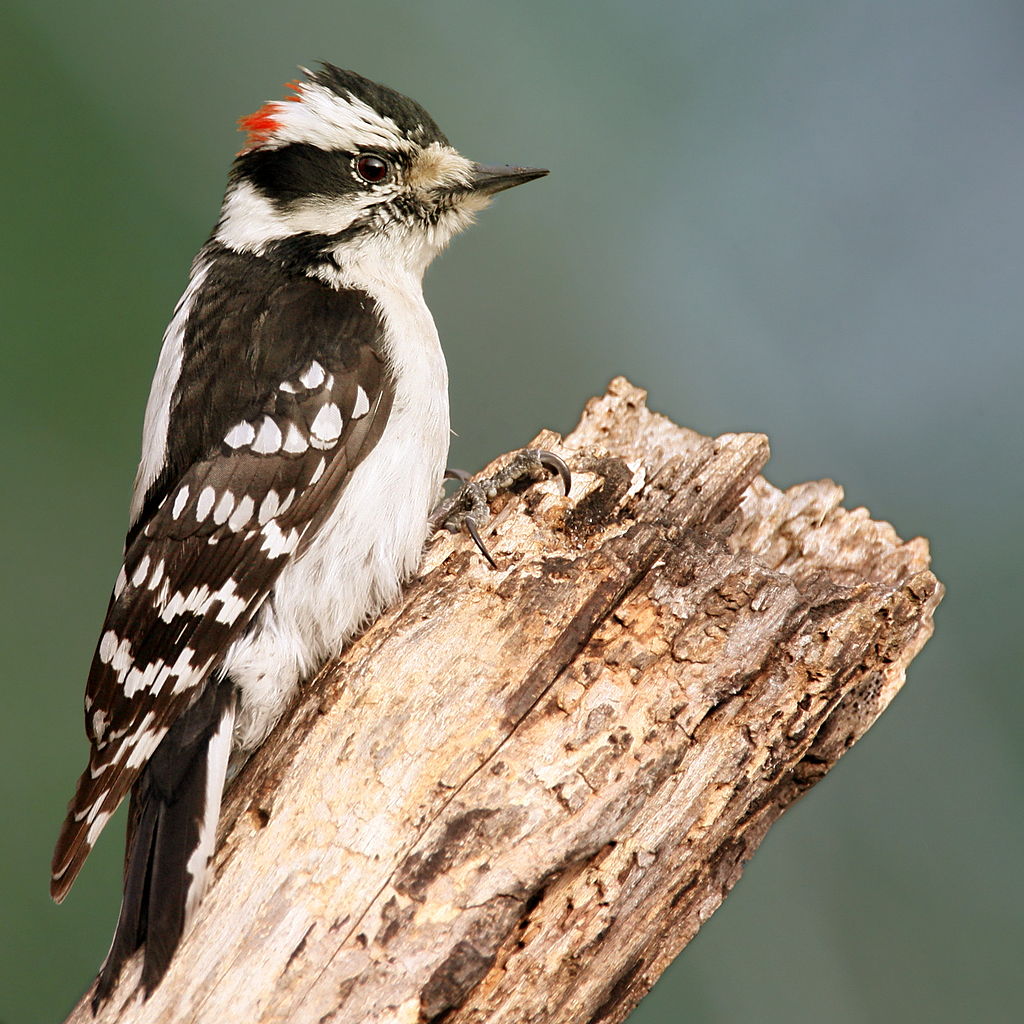
Coloration and Markings: Downy Woodpeckers have white backs with long, black wings with distinct white spots striping across them starting from just below the shoulder and carrying down to the tips of the wings. They have short, black tails which are notches and white on the undersides and their breast and underbelly are snowy-white. Facially, the bird’s face is mostly white, with the exception of a black mustache line, a black eyestripe which goes to the back of the head, and a thin, black cap which terminates at the back of the head at a red spot if the bird is a male. With females, the black cap will simply be black throughout. This bird also displays a tuft of white over the straight, thin, and medium-length black bill.
Size: The smallest North American Woodpecker, the Downy measures in at 5.5 – 6.7 inches in length with a wingspan of 9.8 to 11.8 inches.
Habitat: Thse birds love open woodlands, especially of the deciduous variety with a lot of shrub or brush-cover,. Look for them at the forest’s edge, your local park, and in local backyards. These birds are happy to pay a visit if you leave a little something out for them.
Diet: These Mini-Woodies love suet and Black Oil Sunflower seeds, so be sure to have one or both present in your feeder and you might just earn a visit.
Golden-crowned Kinglet – Regulus satrapa
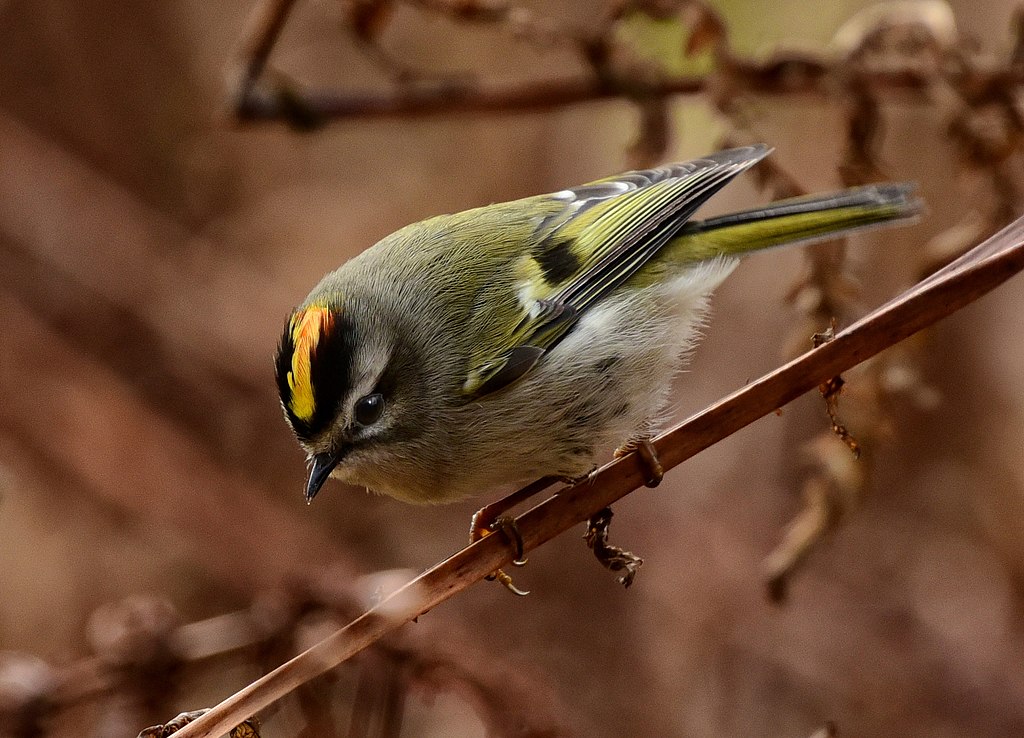
Coloration and Markings: Golden-crowned Kinglets have light gray to olive colored backs, with short wings which are largely yellowish-green, with some gray present and black highlights, as well as a thin, white wingbar on each wing. They have thin, yellow-edged black tails and the breast and underbelly of this bird will be gray and white or olive green or yellow mixed with white. This olive coloration goes to just under the bill, where it is topped by a whitish plumage, and a black mustache line goes down and meets an olive oval of coloration at the cheeks. The cheeks and eyes will be outlines in whitish color and at the forehead there is a black stripe and above this is the bird’s glorious yellow and orange crown (which really looks amazing when ‘puffed up).This bird has a small, conical black bill.
Size: These birds are tiny, measuring in at 3.1 – 4.3 inches from tip to tail and with wingspans of 5.5 to 7.1 inches.
Habitat: In the warm months these birds prefer coniferous woods, but as winter approaches they begin ranging out and may be spotted in swamps, shrubs, or even the suburbs. Be sure to leave a little something out for them as the winters can be a little rough.
Diet: While primarily insectivorous, in the winter months these birds are more than happy to visit the feeder for suet cakes and chunks.
Northern Pygmy Owl – Glaucidium californicum

Coloration and Markings: Northern Pygmy Owls have brown backs with white spots, as well as short brown and white-spotted wings which blacken towards the tips. They also have long, black and white-spotted tails. The breast and underbelly of this bird are white with black streaks and flanked with brown color at the breast and white streaked with black towards the underbelly. Facially, this bird is brown with small white spots and with some white around it’s yellow eyes and spots which circle. You will also notice distinctive white eyebrow lines. This bird has a small, stout, curved yellow bill. Another distinct feature which you will notice is that the head lacks ear-tufts and this makes it look quite circular, like an inverted bowl.
Size: These Owls measure in at 6.3 – 7.1 inches and have a wingspan of approximately 15 inches wide.
Habitat: These birds prefer montane forests but they venture often into towns. As their activity is not limited to nighttime you might just spot one if you are lucky. Look Pygmy Owls around town in the winter when they are the most active in suburban areas.
Diet: You will likely not be able to tempt these birds to your feeder, as they prefer live food such as mice and lizards. That said, you might still see them in your backyard, as sometimes small non-avian animals are spending time at your feeder as well.
Red-breasted Nuthatch – Sitta canadensis
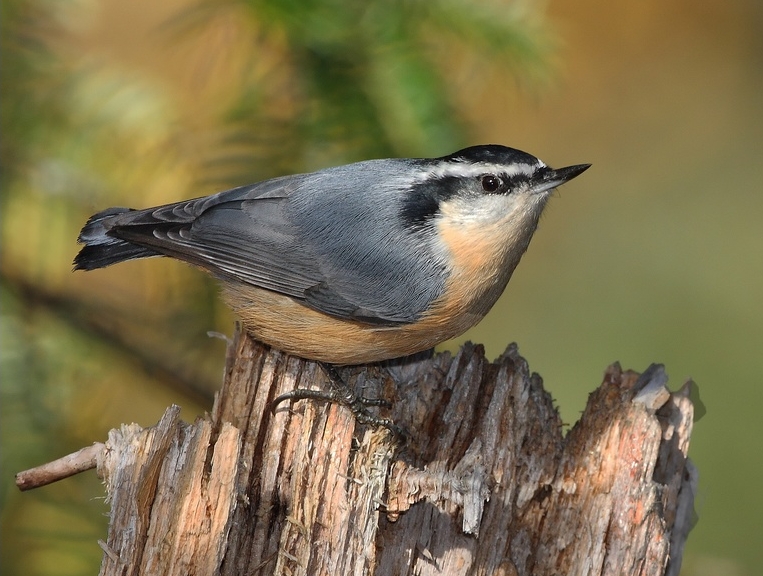
Coloration and Markings: Red-breasted Nuthatches have blue gray backs, long blue-gray wings which are black towards the tips, and short, blue tails edged in black and white. Their breast and underbelly are orange-red, much like a Robin’s, and this carries up and turns white until just under the bill. The remainder of this birds face is white with touches of blue with the exceptions of a black mask which which goes to the back of the head and has a white eybrow line above it, with a black stripe at the top of the head. This bird has a medium-length, straight black bill.
Size: These little guys measure in at approximately 4.3 inchs from tip to tail and have wingspans of 7.1 to 7.9 inches.
Habitat: These birds prefer coniferous woods and are most omfortable in the mountains. Oak, Hickory, and Maple are trees that this bird is especially fond of so look for them near or on these trees.
Diet: Suet, Black Oil Sunflower seeds, and chunky peanut butter are all favorites of the Red-breasted Nuthatch. Leave one or all of these out in your feeder and you might just tempt the bird into a visit.
Supporting cast (Other Backyard Birds of New Mexico that might pay you a visit)
While they don’t get the same billing as our Year-rund resident birds, these ‘Supporting Cast’ birds are out there and ready to be spotted at any time of the year and they are just as fantastic as those front-page flyers. See if you can spot one of these supporting cast cuties this year:
- House Finch
- White-crowned Sparrow
- Spotted Towhee
- House Sparrow
- Mourning Dove
House Finch – Haemorhous mexicanus
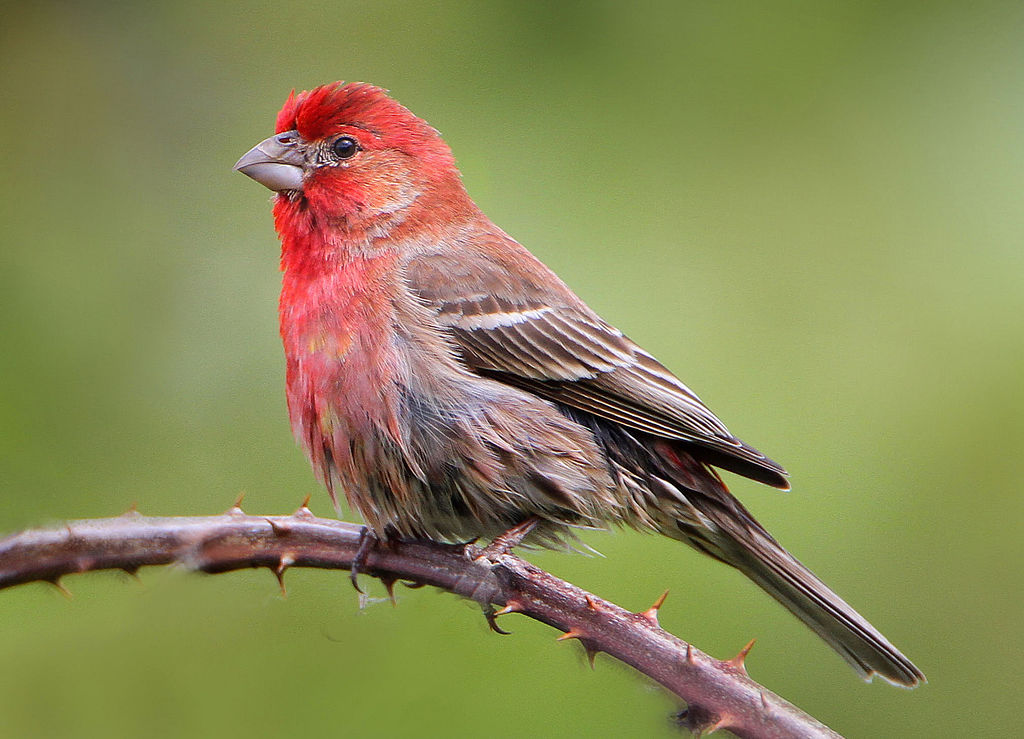
Coloration and Markings: House Finches have brown, streaked backs, with long wings bearing white-edged black stripes and two small, white wingbars. They have long, grayish-brown tails with white edges and their underbelly is gray and white with red streaking which leads to a gray and white breast with a heavy saturation of red color. This red color continues up and takes up most of the male finches face, with the exception of a gray eyeline that goes through the eye and then splits, with one part going to the back of the head and the other framing the cheek. This bird has a stout, gray bill with a noticeable curve on the upper bill and females will display a more more subdued plumage. With females, there will be no red, but rather brown and gray with blurred streaking and facially, the females will lack the facial markings you see in the male.
Size: These birds measure in at 5.5 – 5.5 inches in length and have wingspans of 7.9 to 9.8 inches.
Habitat: These birds love chaparrals, deserts, the forest’s edge, and yet they still make time for towns and cities. These birds aren’t shy about inhabited areas and will happily visit a well-stocked backyard feeder.
Diet: A simple mix of Black Oil Sunflower seeds and Nyjer thistle can tempt and possibly keep the attentions of the House Finch.
White-crowned Sparrow – Zonotrichia leucophrys

Coloration and Markings: White-crowned Sparrows have buff and black streaked backs, with medium-length buff brown and black wings that display 2 thin, white wingbars on each wing. They have lonh, thin, black and brown tails, and display a little brown and white at the rump. The underbelly of this bird is white, with a heavy flanking of brown, and the coloration turns to gray as it travels up, giving the bird a gray breast as well as a stout, gray neck, and this coloration carries up into the face where it terminates at mid-eye level. Above this, the bird is black and white striped, and this bird has a medium-length, conical, pink or orange bill.
Size: These birds measure 5.9 – 6.3 inches from head to tail and have wingspans approximately 8.3 to 9.4 in width.
Habitat: These birds love open wooded areas where brush cover may be found. Thickets, thorns, bushes, and brambles… if these are nearby then the Whtie-crowned Sparrow might be as well.
Diet: A mix of Black Oil Sunflower seeds and Nyjer thistle can get and keep this Sparrow’s attentions.
Spotted Towhee – Pipilo maculatus

Coloration and Markings: Spotted Towhees have black backs and medium-length black wings which have white spots at the shoulder and lower down, like two wingbars made of white dots, and they have long, black tails with white corners underneath. The rump, underbelly, and breast of this bird are a snowy white heavily flanked in an orange-brown ‘vest’ pattern. This coloration is widest at the underbelly and as you look up you will notice that the white breaks in a black v-pattern at the top of the breast. From here on up, the bird’s throat and face are black, and this coloration looks almost like a hood. The look is completed with strikng red eyes and a short, thick, conical black bill.
Size: This bird measures in at 6.7 – 8.3 inches from tip to tail and has a wingspan of approximately 11 inches in width.
Habitat: Spotted Towhees love open areas where there is dense vegetation for cover. Look for them in meadows, clearings, or the edges of woods where the shrubs and brambles are thick. They are also fond of parks and backyards, especially if they meet the bird’s ‘shrub quota’ for comfort.
Diet: Black Oil Sunflower seeds and chopped Cherries are a great combination for tempting the Spotted Towhee.
House Sparrow – Passer domesticus

Coloration and Markings: Male House Sparrows have black, buff, and brown striping on their back, their short wings, and their medium-length tails. Their breast and underbelly have the look of white mixed with soot, with the darkest coloration at the underbelly and with many specks of black at the center of the breast from the bird’s black bib. Facially, beside the bib the bird has white at the base of the throat to the back of the head but higher up in the face, the white only takes up the cheek and the front of the face. This bird has a bicolor mask, which starts black and underlines the eyes but emerges as a brown stripe, which curls down to highlight the cheeks. Above this brown, the bird has gray down the top center of it’s head down to the stout, short, and slightly-curved black bill.
Size: This bird measures in at 5.9 – 6.7 inches in length and has a wingspan of 7.5 to 9.8 inches.
Habitat: These are city and town birds, sometimes spotted at farms but decidedly absent from the woodlands (unless lost). These little guys are most often spotted snatching food at zoos or near park picnics, or simply scoping out backyard feeders in preparation for a feast.
Diet: Cracked corn, wheat, oats, and Black Oil Sunflower seeds are easy foods to leave out and attract the attentions of the House Sparrow.
Mourning Dove – Zenaida macroura
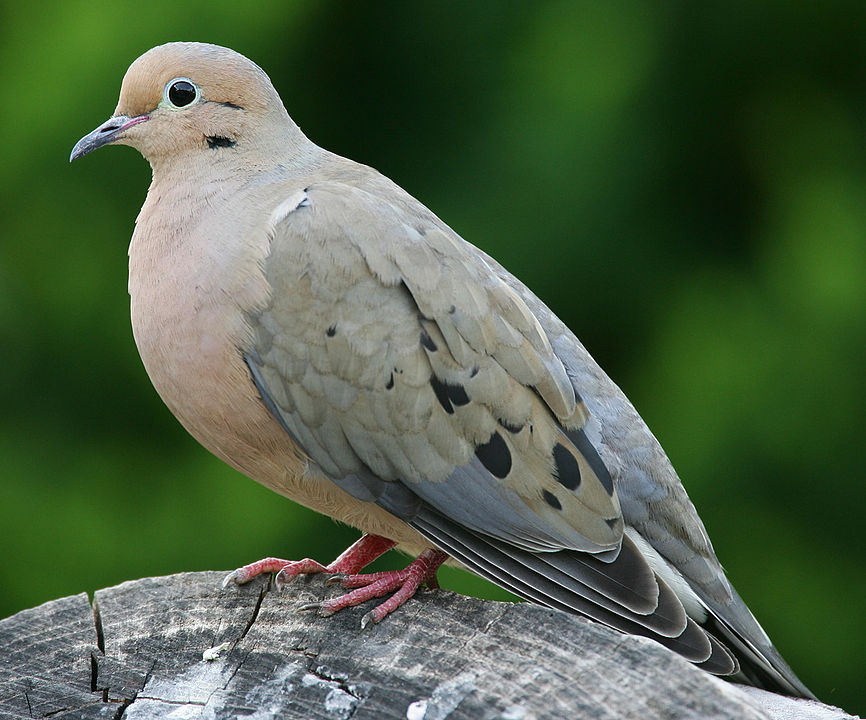
Coloration and Markings: Mourning Doves are typically gray or brownish gray on their back, with long gray or brown wings, which display a heavy saturation of creamy tan color and distinctive large, black spots towards the center of the wing. They have long, pointy gray tails which have white tips and blak edging and the breast and underbelly of this bird are a mix of white and tan, with a small amount of undiluted white just under the wings. Facially, this bird has a heavy pinkish-tan color with a straight, medium-length black bill.
Size: These birds measure in t 9.1 – 13.4 inches from head to tail and have wingspans of approximately 17.7 inches.
Habitat: You can sometimes see these birds at the forest’s edge but never deeper. They prefer parks or simply the city, where they waddle-walk with confidence down the sidewalk, perch on fences, or simply hang out on phone lines and look for backyards will full-feeders.
Diet: Peanuts, cracked corn, ad Black Oil Sunflower seeds are 3 of this Dove’s favorites. Leave them out and see what happens!
New Mexico Bird Buffet
The Santa Fe New Mexican has some great advice for when it comes to stocking up your feeders for the local birds. We’ll be sharing some of their recommended items as well as a few suggestions of our own and with a little trial and error you should be able to fine-tune your feeder to perfection. Check out our reference links if you’d like to see the article which we have mentioned and in the meantime be sure to add some of these items to your feeder this year:
- Black Oil Sunflower seeds
- ‘No mess blends’ (such as Sunflower chips, crushed peanuts, and suet nuggets)
- White Proso millet
- Grape jelly
- Chunky peanut butter
New Mexico Birding Hot Spots
The Chirparazzi know a few places in the Land of Enchantment where you can go and see the stars at their natural best. We’ve taken some suggestions which include Central New Mexico and all of the compass points but if you don’t see anything close, don’t fret! Just use our reference link and you can see a list of more sites in your area and you can find another site that’s hidden just around the corner. When you have some free time try and visit one of these Chirparazzi hotspots:
- Northern hotspot – Window Rock Trail
- Eastern hotspot – Ned Houk Nature Trail
- Southern hotspot – Huco Tanks Nature Trail
- Western hotspot – Continental Divide Trail
- Central hotspot – San Lorenzo Canyon
Detailed descriptions of each location as well as information regarding visiting and what birds you can see at these locations may be found at : https://www.alltrails.com/us/new-mexico/birding
Some Final Words
Today we have discussed birding in New Mexico and if you are a local then color us envious. With over 542 species present, you’ll surely never be bored, but as a birder you’ve definitely got a herculean task in front of you. We hope that you have enjoyed today’s article and we wish you the very best on your next birding adventures in the lovely Land of Enchantment. Happy birding, New Mexican birders!
